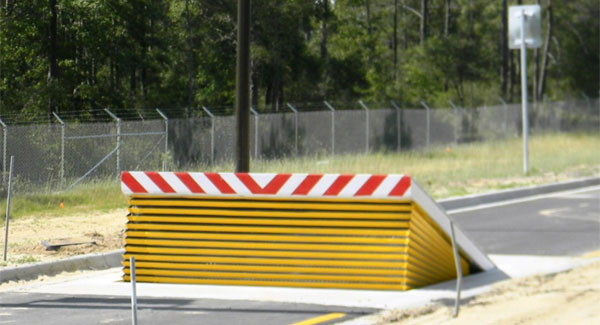The 20-Second Trick For Wedge Barriers
Wiki Article
Wedge Barriers Things To Know Before You Get This
Table of ContentsEverything about Wedge BarriersThe smart Trick of Wedge Barriers That Nobody is Talking About

All About Wedge Barriers
g., springtime support 65 )may be repaired to completion of the springtime pole 58 to allow compression of the springtimes 60. As the springs 60 are compressed in between the spring sustains 62, the springtime assembly 54 creates a force acting on the camera combined to the springtime rod 58 in an instructions 66. For instance, the remaining force put on the cam to release the wedge plate 16 might be supplied by an electromechanical actuator 84 or various other actuator. The spring assembly 54 and the actuator 84(e. g., electromechanical actuator)might run with each other to translate the webcam and raise the wedge plate 16.
As pointed out over, the spring setting up 54 applies a constant force on the cam, while the electromechanical actuator might be regulated to exert a variable force on the web cam, thus allowing the training and decreasing( i. e., deploying and retracting )of the wedge plate 16. In certain personifications, the constant pressure applied by the spring assembly 54 might be adjustable. g., electromechanical actuator) is disabled. As will be valued, the spring assembly 54 may be covered and shielded from particles or other aspects by a cover plate(e. g., cover plate 68 displayed in FIG. 4) that may be significantly flush with the elevated surface 38 of the structure 14. As discussed above, in the deployed placement, the wedge plate 16 serves to block access or traveling past the barrier 10. For instance, the barrier 10(e. g., the wedge plate 16 )may obstruct pedestrians or lorries from accessing a residential or commercial property or pathway. As discussed over, the obstacle 10 is affixed to the support 30 safeguarded within the foundation 14,

front braces 71. Consequently, the affiliation settings up 72 might pivot and revolve to allow the collapse and expansion of the affiliation settings up 72 throughout retraction and release of the bather 10. The linkage assemblies 72 cause movement of the wedge plate 16 to be restricted. For instance, if a car is traveling towards the released wedge plate 16(e. As an example, get redirected here in one circumstance, the safety legs 86 may be extended throughoutmaintenance of the barrier 10. When the safety legs 86 are released, the safety legs 86 support the weight of the wedge plate 16 against the surface 12. As a result, the training device 50 may be deactivated, serviced, removed, changed, etc. FIG. 5 is partial viewpoint view of an embodiment of the surface-mounted wedge-style obstacle 10, showing the web cam 80 and the web cam surface areas 82 of the lifting device 50. Especially, 2 webcam surfaces 82, which are described as reduced web cam surfaces 83, are positioned listed below the cam 80. The reduced web cam webpage surface areas 83 may be dealt with to the surface area 12 (e. For instance, the lower web cam surfaces 83 and the mounting plate 85 might develop a solitary piece that is protected to the support 30 by screws or other mechanical bolts. Furthermore, 2 camera surfaces 82, which are described as upper webcam surfaces 87, are positioned above the cam 80 and paired to (e. In other personifications, interfering layers or plates may be placed between the surface 12 and the lower camera surfaces 83 and/or the wedge plate 16 and the top camera surfaces 87 As stated above, the webcam 80 translates along the camera surface areas 82 when the wedge plate 16 is lifted from the pulled back position to the released position. Furthermore, as mentioned above, the straight from the source springtime setting up 54 (see FIG. 3 )may supply a pressure acting on the camera 80 in the direction 102 through spring pole 58, which may lower the pressure the electromechanical actuator 84 is called for to put on the camera 80 in order to activate and raise the wedge plate 16. 1 )to the released setting(see FIG. 4). As revealed, the web cam 80 consists of track wheels 104(e. g., rollers), which contact and equate along the web cam surfaces 82 during operation.
Report this wiki page